Inspiration comes in dreams. Or maybe the answer, my friend, is blowing in the wind. Be it fever dream or disjointed wind that blows you into The Kennedy Center this December holiday season, you’re in for something a bit unusual when it comes to the National Touring production of Girl From the North Country. Now playing in The Eisenhower Theatre through new year’s eve, this ‘jukebox musical’ (and I use that term very, very loosely) featuring selections from the Bob Dylan song catalogue, is somewhat of curious, albeit haphazard, musical accident. Written and Directed by Conor McPherson, with the music and lyrics of the aforementioned Bob Dylan, Girl From the North Country is— well, an experience. It’s difficult to describe beyond that because it deviates from so many musical theatre archetypes and formats that you’re left wondering what exactly it was you just saw, though not without a deep appreciation for the superb talent that was singing and performing it.
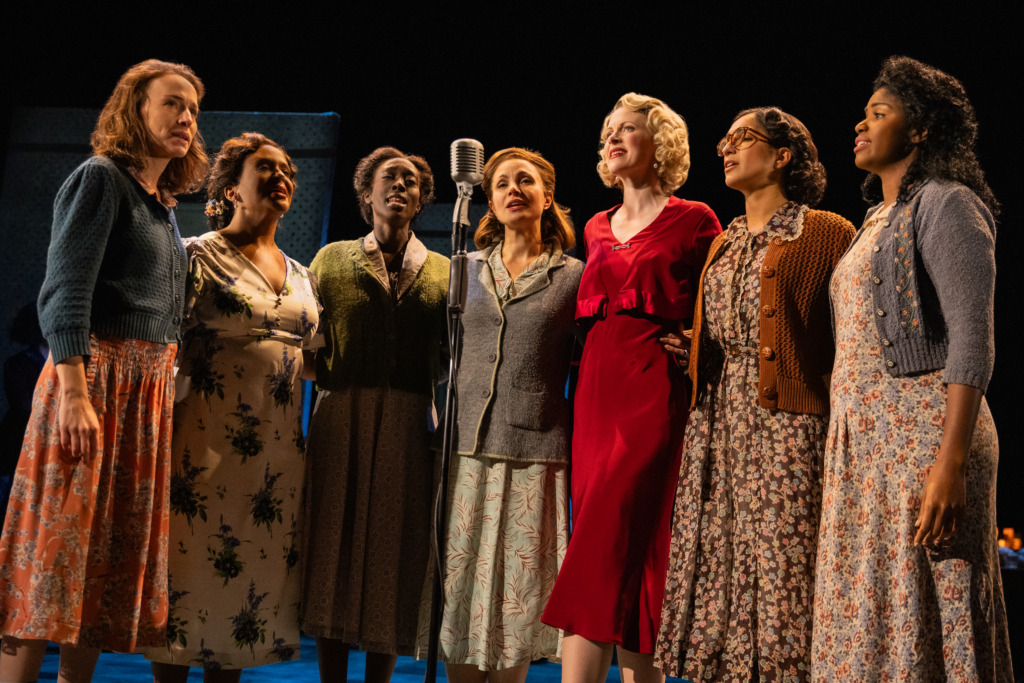
I’ll all for changing the narrative of traditional musical theatre but when the resounding consensus of a great many at the end of the show was “What did we just watch?” it does beg the question. Now I’m not a Bob Dylan aficionado or expert by any stretch of the imagination, but my significant other is and I brought him along with me to Girl From the North Country for some input. He’s not much into musical theatre and I’m not much into Dylan; between the two of us we should be able to formulate a cohesive opinion about what we saw in Girl From the North Country. It’s two days post-mortem and we’re both still puzzling over it. I think the best way to describe this show is a bit like a handmade Christmas project. Conor McPherson decided he was going to weave a tapestry of Dylan songs together but realized music alone, at least in this sense, can’t make a whole story. So he fabricated one out of narrative fragments that borrow from history and other staged storytelling experiences (the narrative character of Dr. Walker reads a good deal like the narrative figure from Thornton Wilder’s Our Town.) But somewhere along the way, a lot of the threads got tangled, jumbled, and frayed; by the evening’s end there were so many unfinished loose ends and unraveled moments of confusion it wasn’t really clear what had just happened. My other half likens this experience to Bob Dylan’s only autobiography, Chronicles, which deliberately refuses to go in order or make linear sense of itself. And while I think that might be a bit of a stretch as Girl From the North Country does have fleeting moments of forward linear progression, it certainly does dance all around in a tangle of half-finished, incomplete, untold tales from the moment it starts to the moment it ends.
I think the chief complaint, or at least the ‘why would you do that?’ question that resounded the most, from both my s/o and various audience members we spoke with while attending the performance is “How can you call it Girl From the North Country and not feature the song ‘Girl From the North Country?’ anywhere in the show?” (Technically, it’s listed in the program’s running list of songs… but there were several songs listed in there who featured a single chorus-line from that song, and if this was the case with the titular number, it was so rapidly rushed through or blended so obscurely into a montage mashup, that a great many people didn’t notice.) I suppose only Conor McPherson and Bob Dylan have the answers for that somewhere (blowing in the wind, maybe, which like the titular number, was not featured in this production.) While not knowing Dylan’s catalog as well as my s/o, I did agree with him 100% that the song selection used for the show seemed to have very little to do with what was happening on stage and also little to nothing to do with Dylan himself. This wasn’t set up like a Dylan origin story but it wasn’t shoehorning a story to fit the songs (like Escape to Margaritaville or Head Over Heels, Jagged Little Pill, etc.) For me, some of the songs really carried a beautiful emotional intent behind them— even if the lyrics and the meaning behind the lyrics seemed completely out of place for where they fell in this jumble of diverting and meandering storylines.
The show opens abruptly, with musicians pedaling around the stage in that pre-show immersive-attempt to engage the audience with what’s happening. And full lights up, no warning—BAM “Sign On the Window” kickstarts the evening from somewhere out in left field. You do learn, as the song breaks down, by way of omnipotent narrative figure Dr. Walker (Alan Ariano), that the story starts in November of 1934 in Deluth, Minnesota and ends in November of 1934 in Deluth, Minnesota. The show takes place in an old ‘guest house’ or boarding house, just in the middle of the Great Depression, where times are hard, situations are harder, and nobody has a good life. There’s four sets of storylines all sweeping and swishing in and out of this boarding house? At least it feels like four, or at least four main ones, with little tangents diverging all over the place. You need a heavily marked and color-coded diagram to really get the bigger picture of who is who and what is what.
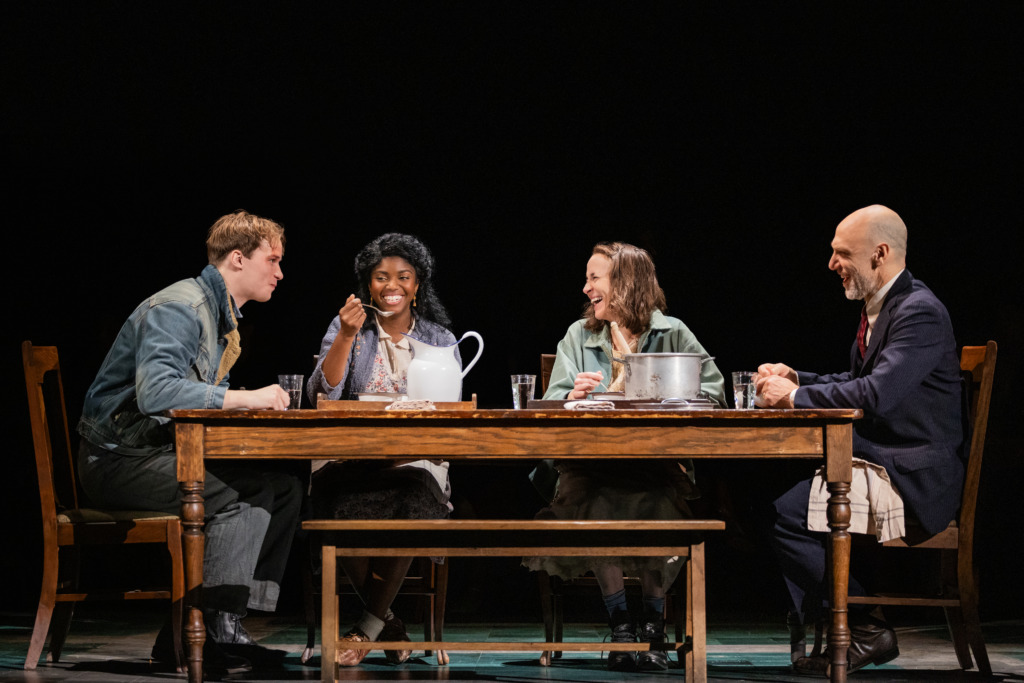
The problem with McPherson’s libretto and overall structuring of this show is that you never get enough information about what’s actually going on. And if this were truly little vignettes of these people’s lives where you just get a blink or a glimpse of their story and a song to go with it and then move along to the next one, that would probably be just fine. But McPherson goes just far enough into each of the character’s stories to make you want to be interested but then pulls back, fails to deliver on both detail and explanation, and often times on conclusion, leaving you feeling dissatisfied and curios and frustrated. That’s not to say there aren’t some very touching or gasp-worthy moments that truly shake you up or shock you through, but on the whole, it’s a jumbled, narrative cacophony.
In speaking with another reviewer from TheatreBloom, who grew up out at the lakes, he has informed me that if you’re from Deluth or areas of the like that sit on the lakes, there’s a specific type of storytelling that happens out at these lakes, with large groups of people, gathered round a fire, picking instruments, singing songs, telling stories, all at once, and everyone hears everything and nothing all at once and nobody’s full story ever really gets told. And if that’s the case— then this musical, Girl From the North Country is an exquisite reflection of that cultural practice and will be thoroughly enjoyed by those who have experienced this way of life in real time. But for those expecting something more traditional, structured, or linear, this may not be the musical for you. That’s not to say that the performances aren’t stellar— they are; the vocalists are top notch and some of the songs, being mashed and blended together in the style that they are, are truly impressive— but if you need more than beautiful sounds making music around a jumbled story to engage you for an evening’s theatrical endeavor, this may not be the show for you.
If there’s one thing to be said about the physical structuring of what happens on stage, it’s the praises of movement director Lucy Hind. While there isn’t any choreography (except the one background dance routine towards the end) to speak of, everything that happens in motion on that stage is a type of choreographed routine and Hind does this flawlessly. As bits and brambles of these stories knock loose on the stage, the ‘boarding house’ assembles and disassembles before the audiences eyes in fluid, seamless motions, all carried out by the performers. There’s also musicians on stage— some of whom double up as performers, like Jill Van Velzer, who spends a good deal of time at the drum kit downstage left, but also plays Mrs. Burke in the grander scheme of folks coming and going from the boarding house. Hind’s coordination of movement on stage keeps this performance flowing like a surging river— so much so that a musical number has hardly exhaled its last note when dialogue picks up. The audience is never given the chance to applaud. (Once at the intermission and once at the end during curtain call.) The pacing is what keeps the audience on this disorienting, dizzying ride; you don’t have a moment to think about what’s missing, what’s not making sense, where we’ve just jumped to in the narrative spectrum, and where all the important need-to-know details about these characters have gone to. And normally I would say pacing like this detracts from the show because you need a minute to breathe it all in and digest it, but because the libretto is such a tangle of confusion and half-finished stories, this pacing, actually sweeps you along in a way that lets you appreciate the music and not think too deeply on the things you’ll be forced to chew over later.
As mentioned, the Dylan catalog song selections are varied (and according to my significant other, somewhat more obscure— though he knew every song— than one might expect for a stage musical featuring the work of Bob Dylan. But as it turned out to neither be about Dylan’s life or about the songs Dylan wrote…) One of the most striking and powerful moments in the production is the finale where 17 vocalists stand in a line at the front of the stage, belting to the rafters in full acapella a version of “Pressing On” (from the Dylan album ‘Saved’-1980.) The sound was so overwhelming, you could feel it reverberating inside your bones; a truly powerful and astonishing moment, with this holy and pious sound, giving the impression that they’re pressing onward to the afterlife. It was indeed a choice to use that song as the show’s finale piece, but the style in which it was done, the vocal integrity with which it was presented, and the overall emotional depth delivered in that moment cannot be questioned. This finale number features the full company of perfectly blended voices (at this performance: Alan Ariano, David Benoit, Ben Biggers, Kelly McCormick, Rayla Garske, Warren Nolan Jr., Jay Russell, John Schiappa, Chiara Trentalange, Jill Van Velzer, Jeremy Webb, Aidan Wharton, Carla Woods, Ashley D. Brooks, Justin Michael Duval, Danny Vaccaro, Hosea Mundi, Housso Semon,) and is the epitome of a perfect ending, even if the show was somewhat questionable.
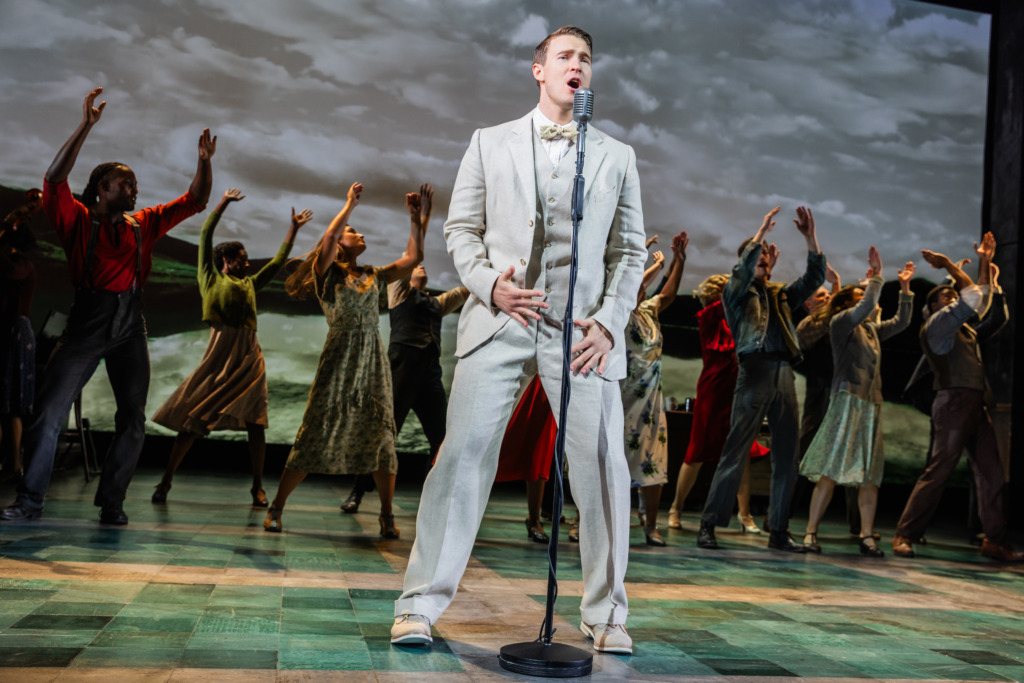
One of the more fascinating characters, who you received so little of, in the show was Elias (Aidan Wharton), who was meant to be the young adult song of Mr. & Mrs. Burke (David Benoit and Jill Van Velzer, respectively) but who was autistic— or as they would have referred to him in 1934, ‘touched.’ You get these astonishing childlike moments and though you see very little of Wharton’s character, when he is on stage, his performance stands out. Then a thing happens. (No spoilers here.) And like a comet hurling from space and smashing into the side of a building, Wharton just appears, in this glowing white lighting (by way of Lighting Designer Mark Henderson, who has done an extraordinary job of playing with light, darkness, shadows, and silhouettes all throughout this production) and this silvery, grown-up suit, and blasts the audience with this high-octane, tin-pan-alley-jazz-jumble rendition of “Duquesne Whistle” (which is from the 2012 album, ‘Tempest’. It’s worth noting that this is the only number from any of Dylan’s ‘modern’ albums.) Wharton gives a heart-stopping performance and it’s truly remarkable.
There are other moments like Wharton’s moment in the spotlight that come to mind, which once again supports my theory of “the emotional intent behind the song being delivered matches the narrative far better than the song and lyrics itself.” This is also true of “Is Your Love in Vain?” (from the 1978 album ‘Street Legal.’) where David Benoit and Jill Van Velzer, as Mr. and Mrs. Burke respectively, are singing this emotionally sobering side-apart duet at one another from a distance, reflecting the experience they’ve both shared, without actually sharing it. Mrs. Neilsen (Carla Woods) has a similar moment at the top of the show, singing with her stunning, captivating voice, “Went to See the Gypsy” (from the 1970 ‘New Morning’ album.) And you get this extraordinary sound, exquisite sense of emotional connection, but an odd disconnect between what’s happening with her character at the boarding house in that moment and the lyrics she’s actually singing.
The performance itself is also chock-a-block with acting talent. Despite the jumble of the stories, you do get some earnest character work (and I think that’s part of the frustration with this piece… some of these characters feel so deeply lived in that not getting their stories, or even half of their stories, is infuriating because they’re being portrayed so intensely by these actors on stage.) Reverend Marlowe (Jermy Webb) is one such, with cadence and delivery to his speeches that will set your teeth on edge.
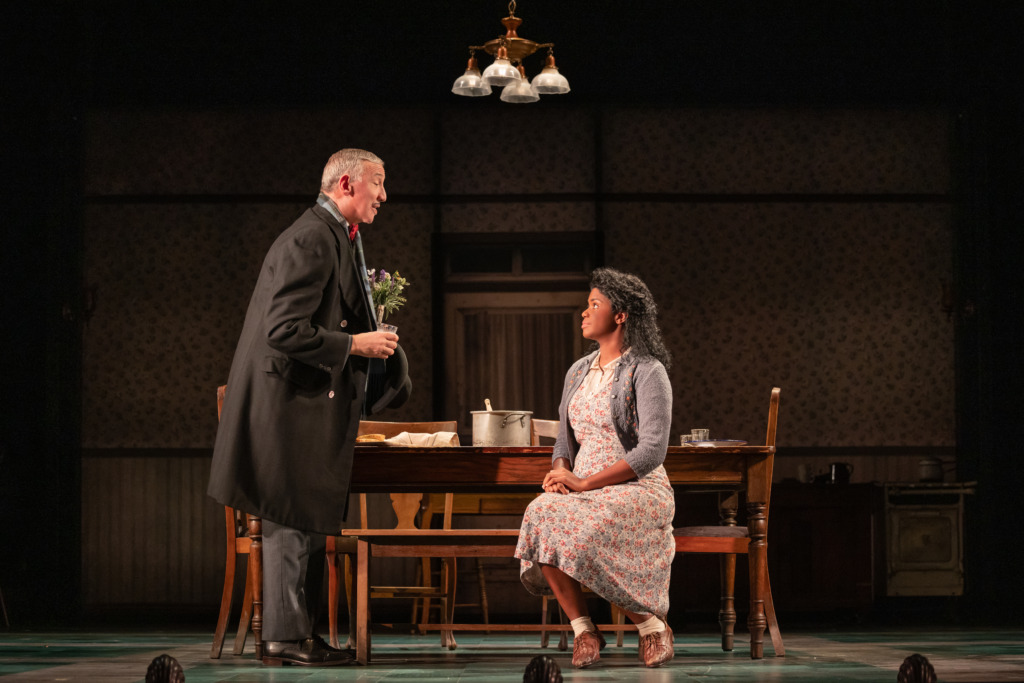
There’s a sorrow that gnaws away at the pit of your stomach when it comes to the pitiful nature Jay Russel presents as Mr. Perry the shoe-salesman; he has a long-winded monologue about growing old and how no one wants to do that but its inevitable for those who are lucky; the speech is brutally honest and deeply moving as he delivers it. And there’s comic relief built up in the mentally-unwell character of Elizabeth Laine (at this performance, Kelly McCormick.) You get this frigid yet proper presentation of an otherwise completely dismissible character from Chiara Trentalange, playing Kate Draper. You only ever see her coming in to break Gene Laine’s (Ben Biggers) heart. You get this tragically beautiful duet-apart from Trantalange and Biggers, during “I Want You” and you almost feel like that storyline could go somewhere. But it frays apart and dissolves into the perpetually frenetic chaos of life on stage.
(At this performance) Warren Nolan Jr., as Joe Scott, the poor traveler who shows up at the boarding house one night in a horrid storm, accompanied by the Reverend Marlowe, is one of the most fascinating characters, mostly because you never really learn who he is or why or how he came to be there. Bits and pieces trickle out and you get flustered all over again when you realize you’re never truly going to know. But Nolan Jr. has a glorious voice, taking on hints of that Aaron Neville sweet high-top sound when he sings. You get intense emotional conviction from Nolan Jr. when he sings “All Along the Watchtower” (from the 1967 album ‘John Wesley Harding’) And while her non-singing stage chemistry is somewhat uneven, Rayla Garske, (at this performance as Marianne Laine), delivers a striking musical blow when she leads off “Idiot Wind” (from the 1975 ‘Blood on the Tracks’.)
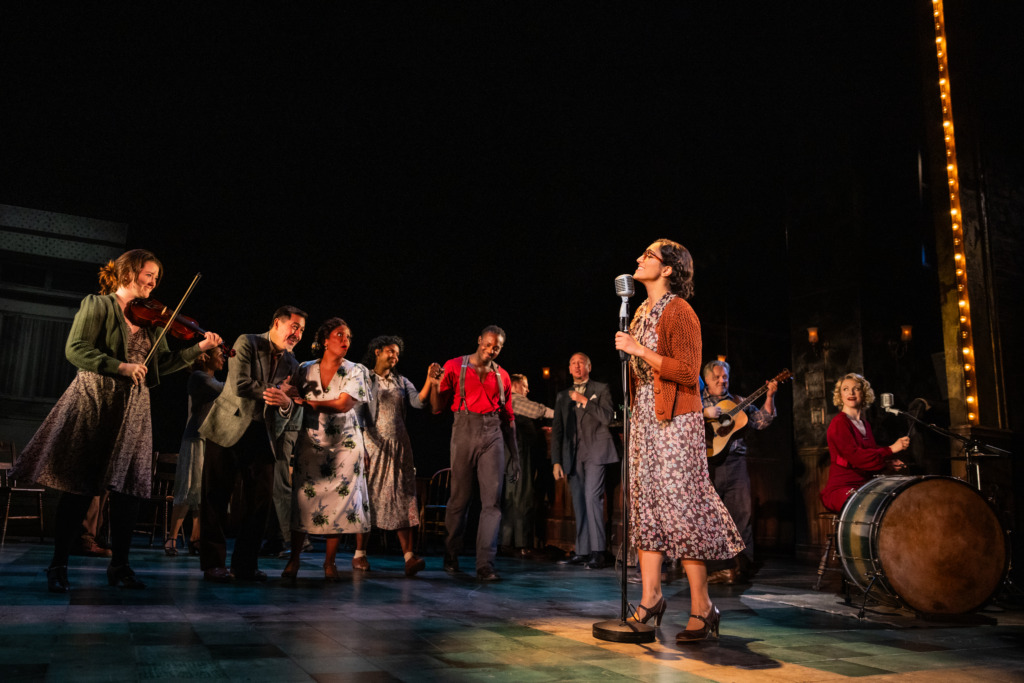
It’s a glorious musical exploration and pieces of the narratives really are quite affecting. I wouldn’t say it’s Tony-worthy (and apparently neither would the Tony Award committee) but it’s certainly unique and if you’re intrigued by half-finished stories, filled with loose-ends and fascinating characters that you never really get to experience fully, and you love some of the more obscure songs that Bob Dylan has created along his prolific career as a singer-songwriter, then Girl From the North Country will be well worth attending for you. If you’re looking for something unique and different this holiday season, Girl From the North Country is also definitely for you. I would approach it with an open mind, expecting a really good concert with some narrative bits sprinkled in.
Running Time: 2 hours and 35 minutes with one intermission
Girl From The North Country plays through December 31st 2023 in the Eisenhower Theatre at The John F. Kennedy Center for the Performing Arts, 2700 F Street NW, Washington, DC. For tickets call the box office at (202) 467-4600 or purchase them online.
